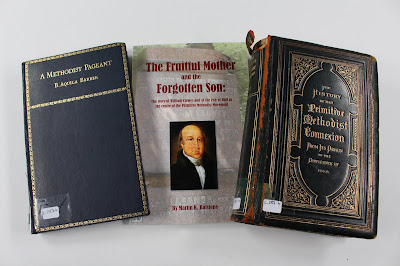On the 9th June 1948, the International Council on Archives (ICA) was created. Since 1948, this date has been celebrated as International Archives Day. The aims of the ICA are to support and develop best practice within archives, and to promote awareness across the world.
To mark International Archives Day we bring you a brief tour, in pictures, of Hull History Centre’s collections.
 |
| Exterior of Hull History Centre showing our 'Larkin Toad' |
And the tour starts outside the building, with a piece of sculpture which some of you might remember as being part of the Larkin Toad trail. The association of the poet Philip Larkin with Hull History Centre is two-fold: firstly, the centre holds his personal archives, including workbooks, letters, photographs and library; and secondly, as Librarian, Larkin’s support for the development of the University of Hull’s manuscript collection laid the groundwork for what became the University Archives Service (now part of Hull History Centre). The toads are a nod to one of Larkin’s most famous poems. In addition to Larkin’s papers, the History Centre holds some other notable literary collections, like the papers of novelist and feminist reformer, Winifred Holtby (1898-1935), and the papers of novelist, playwright and screenwriter, Alan Plater (1935-2010).
 |
| Larkin workbook page showing a draft of the poem 'Toads' [U DPL/1/3] |
The bulk of the History Centre’s holdings consist of records created by Hull City Council and its predecessors. These records document the history of the city from some of the very earliest years of the settlement. One of the earliest documents, and perhaps most locally significant, is the charter granted by King Edward I in 1299. Written in Latin on parchment, the charter enabled the fledging settlement to become a borough, a self-governing community, with its own court, coroner, market and authority to collect taxes. This began the process which led to Hull becoming the thriving city we know today.
 |
| Charter of King Edward I, 1299 [C BRC/1] |
And from the high and mighty documents which guard the legal rights of our city, to the mundane council records that are necessary for the daily life of a city.... The History Centre also holds records which document the drive to improve housing conditions during the 1920s and 1930s. The following image records the laying of pipes necessary for the conversion of old privies into water closets.
Layout of the new drainage for 53 Freehold Street, in the west of the city, 1928 [C TAP/73/125]
The History Centre’s holdings don’t just document the local situation, they also demonstrate the international connections and relationships which the city has had over the centuries. Hull has a number of links and twining arrangements with many places across the world, including Rotterdam, Reykjavik, Freetown, Szczecin, Niigatta and Raleigh. This document records a 1967 visit to Hull made by a party of civic dignitaries from Rotterdam.
 |
| Itinerary for the visit of a group from Rotterdam, including Mayor W. Thomassen, 1967 [C SRL/E/178] |
Some of the History Centre’s most well-used collections are the papers of notable landed families which document the workings of their estates and the political careers of prominent family members. The records of the Sykes family of Sledmere in the East Riding of Yorkshire are an example of how archives can be used to look into the origins of political tensions. Sir Mark Sykes (1879-1919), was a noted traveller, diplomat and British politician. He was heavily involved in the Middle East and his papers help to shed light on the Arab Revolt and the collapse of the Turkish Empire during the First World War.
 |
| Map of the Euphrates district, 1910 [U DDSY2/4/72] |
Within the Local Studies Library there are many examples of scrapbooks which have been compiled by various antiquarians and researchers, and which reflect the interests of the compiler. This image, from the ‘Yorkshire Scrapbook’ shows the page for Hull and was compiled in the mid nineteenth century. It brings our attention to various events, including the importation of over a million leeches in 1825!
 |
| Page from the 'Yorkshire Scrapbook' [L DLYS/1] |
Finally, with an eye to a historical future that never was, we take a look at what the city might have looked like, had the vision of town planners Sir Patrick Abercrombie and Sir Edwin Lutyens been put into practice. Developed in 1945 with the intention of regenerating the heavily blitzed city, it was certainly a bold vision of the future. However, it was unpopular with local politicians and businesses, and would have required vast amounts of funding and resources at a time of economic difficulty. Had it been done our city would be very different from today!
 |
| View of Hull as proposed by Abercrombie and Lutyens [L.711A] |
The vision of the Hull History Centre is to make history available to all, for research, for learning and for leisure. We want to inspire everyone to take an interest in the city of Hull, it’s past, present and future. We hope we’ve inspired some of you to come and see what else we hold. All that remains is to day ‘Happy International Archives Day’!
Paul Leaver, Archivist/Librarian (Hull City Archives and Local Studies)








































